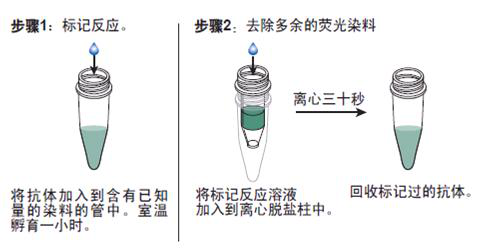
|

| 产地 | 进口、国产 |
| 品牌 | 上海莼试 |
| 保存条件 | Store at -20 °C |
| 货号 | CS12352 |
| 应用范围 | WB=1:100-500 ELISA=1:500-1000 IHC-P=1:100-500 IHC-F=1:100-500 ICC=1:100-500 IF=1:50-200 |
| CAS编号 | |
| 抗体名 | Anti-SDHC |
| 克隆性 | 是 |
| 靶点 | 详见说明书 |
| 适应物种 | 详见说明书 |
| 形态 | 详见说明书 |
| 宿主 | 详见说明书 |
| 亚型 | IgG |
| 标识物 | 详见说明书 |
| 浓度 | 1mg/1ml% |
| 免疫原 | KLH conjugated synthetic peptide derived from human Succinate dehydrogenase complex subunit C/SDHC |
产品订购信息:
英文名称 Anti-SDHC
中文名称 琥珀酸细胞色素亚基B560抗体说明书
别 名 mitochondrial; QPs1; C560_HUMAN; CYBL; Integral membrane protein CII-3; QPs-1; sdhC; Succinate dehydrogenase complex subunit C; Succinate dehydrogenase cytochrome b560 subunit; Succinate dehydrogenase cytochrome b560 subunit, mitochondrial precursor; Succinate-ubiquinone oxidoreductase cytochrome B large subunit.


浓 度 1mg/1ml
规 格 0.2ml/200μg
抗体来源 Rabbit
克隆类型 polyclonal
交叉反应 Human
产品类型 一抗
研究领域 细胞生物 发育生物学 神经生物学 信号转导 表观遗传学
蛋白分子量 predicted molecular weight: 15kDa
性 状 Lyophilized or Liquid
免 疫 原 KLH conjugated synthetic peptide derived from human Succinate dehydrogenase complex subunit C/SDHC
亚 型 IgG
纯化方法 affinity purified by Protein A
储 存 液 Preservative: 15mM Sodium Azide, Constituents: 1% BSA, 0.01M PBS, pH 7.4
琥珀酸细胞色素亚基B560抗体说明书 产品应用 WB=1:100-500 ELISA=1:500-1000 IHC-P=1:100-500 IHC-F=1:100-500 ICC=1:100-500 IF=1:50-200
(石蜡切片需做抗原修复)
not yet tested in other applications.
optimal dilutions/concentrations should be determined by the end user.
保存条件 Store at -20 °C for one year. Avoid repeated freeze/thaw cycles. The lyophilized antibody is stable at room temperature for at least one month and for greater than a year when kept at -20°C. When reconstituted in sterile pH 7.4 0.01M PBS or diluent of antibody the antibody is stable for at least two weeks at 2-4 °C.
Important Note This product as supplied is intended for research use only, not for use in human, therapeutic or diagnostic applications.
产品介绍 Membrane-anchoring subunit of succinate dehydrogenase (SDH) that is involved in complex II of the mitochondrial electron transport chain and is responsible for transferring electrons from succinate to ubiquinone.
Function : Membrane-anchoring subunit of succinate dehydrogenase (SDH) that is involved in complex II of the mitochondrial electron transport chain and is responsible for transferring electrons from succinate to ubiquinone (coenzyme Q).
Subunit : Component of complex II composed of four subunits: the flavoprotein (FP) SDHA, iron-sulfur protein (IP) SDHB, and a cytochrome b560 composed of SDHC and SDHD.
Subcellular Location : Mitochondrion inner membrane.
DISEASE : Defects in SDHC are the cause of paragangliomas type 3 (PGL3) [MIM:605373]. A neural crest tumor usually derived from the chromoreceptor tissue of a paraganglion. Paragangliomas are most commonly located in the head and neck region, specifically at the carotid bifurcation, the jugular foramen, the vagal nerve, and in the middle ear.
Defects in SDHC are a cause of paraganglioma and gastric stromal sarcoma (PGGSS) [MIM:606864]; also known as Carney-Stratakis syndrome. Gastrointestinal stromal tumors may be sporadic or inherited in an autosomal dominant manner, alone or as a component of a syndrome associated with other tumors, such as in the context of neurofibromatosis type 1 (NF1). Patients have both gastrointestinal stromal tumors and paragangliomas. Susceptibility to the tumors was inherited in an apparently autosomal dominant manner, with incomplete penetrance.
Similarity : Belongs to the cytochrome b560 family.
Involvement in disease:Defects in SDHC are the cause of hereditary paragangliomas type 3 (PGL3) [MIM:605373]; also known as autosomal dominant non-chromaffin paragangliomas type 3. Non-chromaffin paragangliomas are usually benign, neural crest derived tumors of parasympathetic ganglia.
Defects in SDHC are a cause of paraganglioma and gastric stromal sarcoma (PGGSS) ; also known as Carney-Stratakis syndrome. Gastrointestinal stromal tumors may be sporadic or inherited in an autosomal dominant manner, alone or as a component of a syndrome associated with other tumors, such as in the context of neurofibromatosis type 1 (NF1). Patients have both gastrointestinal stromal tumors and paragangliomas. Susceptibility to the tumors was inherited in an apparently autosomal dominant manner, with incomplete penetrance.

甘露醇卵黄多粘菌素琼脂平板(MYP)2838mX20个用于蜡样芽孢杆菌的菌数测定及分离培养(GB/T4789.28-2003中4.64,GB/T4789.03,SN02和...
土霉素葡萄糖酵母提取物选择性培养基(OGYE培养基) (CM0545) Oxoid incubation media 土霉素葡萄糖酵母提取物选择性培养基(OGYE培养基) (CM0545) Oxoid
炭黑曲霉 分离源:发酵剂 支/瓶
心浸液琼脂250g用于培养营养要求高的微生物
克氏双糖铁琼脂 250g 用于细菌复合生化试验(葡
甘露醇盐琼脂(USP)250g用于金黄色葡萄球菌选择性分离培养
金黄色葡萄球菌显色培养基 1000 mL/瓶 incubation media 金黄色葡萄球菌显色培养基 1000 mL/瓶
PALCAM琼脂冻干配套试剂 10支 每支添加于100ml(026070)中配成PALCAM琼脂。
琼脂培养基NAgarmediumN(Cetrimideagar)用于绿脓假单胞菌的分离培养。
LactobacillusSelectiveAgar
SSDC培养基(ISO)250g用于小肠耶尔森氏菌的分离培养
MKTTn肉汤 MKTTn Broth 用于食品中沙门氏菌检验选择性增菌(ISO标准)
猪胆汁粉 Bile powder of pig 100克 BR
Raka-Ray3号培养基250g/瓶用于啤酒和酿造过程中乳酸菌的分离incubationmediaRaka-Ray3号培养基250g/瓶用于啤酒和酿造过程中乳酸菌的分离
TTC溶液(0.125%) 2ml*5 添加于HB0127中
CL-0202Saos-2(人细胞)5×106cells/瓶×2
TNFRSF14 Others Mouse 小鼠 HVEM / TNFRSF14 CHO细胞裂解液 (阳性对照)
人雪旺细胞cDNAHSC cDNA
猪内皮细胞;ZYM-SVEC01 细胞,SW1353细胞 EMT-6细胞,小鼠癌细胞株
人整合SV40基因的上皮细胞;HBL-100 [HBL100]
HA Others H1N1 甲型 H1N1 (A/WSN/1933) 血凝素HA1 (Hemagglutinin) 人细胞裂解液 (阳性对照)
琥珀酸细胞色素亚基B560抗体说明书CL-0200RWPE1(人上皮细胞)5×106cells/瓶×2
PBK Others Human 人 PDK / PDZ binding kinase / TOPK 杆状病毒-昆虫细胞裂解液 (阳性对照)
人少突胶质前体细胞cDNAHOPC cDNA
MCF-7细胞,人癌细胞 人肺鳞癌细胞,LTEP-s细胞 滑膜细胞Many types of cells包装:5 × 105次方(1ml)
犬肾细胞系/野生型;MDCK/wild
PLAT Others Human 人 tPAβ 人细胞裂解液 (阳性对照)

抗体的生物素化标记实验要点:
1. 琥珀酸细胞色素亚基B560抗体说明书 如在反应混合液中有叠氮钠或游离氨基存在,会抑制标记反应。因此,蛋白质在反应前要对 0.1mol/L碳酸氢钠缓冲液或0.5mol/L硼酸缓冲液充分透析;
2.所用的NHSB及待生物素化蛋白质之间的分子比按蛋白质表面的ε-氨基的密度会有所不同,选择不当则影响标记的效率,应先用几个不同的分子比来筛选最适条件;
3.用NHSB量过量也是不利的,抗原的结合位点可能因此被封闭,导致抗体失活;
4.由于抗体的氨基不易接近可能造成生物素化不足,此时可加入去污剂如 Triton x-100, Tween20等;
5.当游离ε-氨基(赖氨酸残基的氨基)存在于抗体的抗原结合位点时,或位于酶的催化位点时,生物素化会降低或损伤抗体蛋白的结合力或活性;
6.生物素还可能与不同的功能基团,如羰基、氨基、巯基、异咪唑基及苯酚基,也可与糖基共价结合;
7.交联反应后,应充分透析,否则,残余的生物素会对生物素化抗体与亲和素的结合产生竞争作用;
8.在细胞的荧光标记实验中,中和亲和素的本底低,但由于链霉亲和素含有少量正电荷,故对某些细胞可导致高本底。
抗体的鉴定:
1)琥珀酸细胞色素亚基B560抗体说明书 抗体的效价鉴定:不管是用于诊断还是用于,制备抗体的目的都是要求较高效价。不同的抗原制备的抗体,要求的效价不一。鉴定效价的方法很多,包括有试管凝集反应,琼脂扩散试验,酶联免疫吸附试验等。常用的抗原所制备的抗体一般都有约成的鉴定效价的方法,以资比较。如制备抗抗体的效价,一般就采用琼脂扩散试验来鉴定。
2)抗体的特异性鉴定:抗体的特异性是指与相应抗原或近似抗原物质的识别能力。抗体的特异性高,它的识别能力就强。衡量特异性通常以交叉反应率来表示。交叉反应率可用竞争抑制试验测定。以不同浓度抗原和近似抗原分别做竞争抑制曲线,计算各自的结合率,求出各自在IC50时的浓度,并按公式计算交叉反应率。
如果所用抗原浓度IC50浓度为pg/管,而一些近似抗原物质的IC50浓度几乎是无穷大时,表示这一抗血清与其他抗原物质的交叉反应率近似为0,即该血清的特异性较好。
3)抗体亲和力:是指抗体和抗原结合的牢固程度。亲和力的高低是由抗原分子的大小,抗体分子的结合位点与抗原决定簇之间立体构型的合适度决定的。有助于维持抗原抗体复合物稳定的分子间力有氢键,疏水键,侧链相反电荷基因的库仑力,范德华力和空间斥力。亲和力常以亲和常数K表示,K的单位是L/mol。抗体亲和力的测定对抗体的筛选,确定抗体的用途,验证抗体的均一性等均有重要意义。